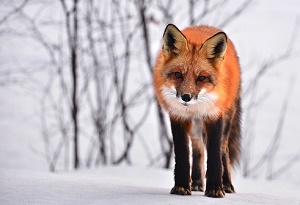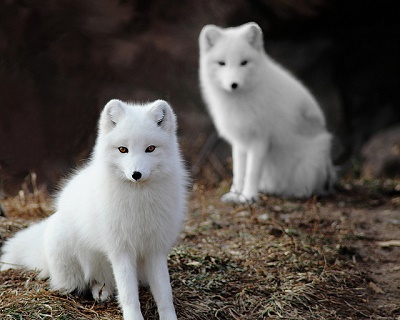| Kingdom: | Animalia |
| Phylum: | Chordata |
| Class: | Mammalia |
| Order: | Carnivora |
| Family: | Canidae |
| Scientific Name: | Vulpes vulpes |

Foxes are small-to-medium-sized, omnivorous mammals belonging to family Canidae.
Foxes are slightly smaller than a medium-size domestic dog, with a flattened skull,
upright triangular ears, a pointed, slightly upturned snout, and a long bushy tail.
The fox is a nocturnal mammal, meaning that the fox only goes out a night to hunt
for prey.
There are around 12 different species of fox found around the world, which include the urban fox or red fox, the beautifully white Arctic fox, the sand fox which is a light-coloured fox found in desert regions and the tiny yet big eared fennec fox.
Features
Fox typically have a triangular face, pointed ears, an elongated rostrum, and a bushy tail. Foxes are digitigrade, and thus, walk on their toes. Unlike their dog relatives, foxes have partially retractable claws. Fox vibrissae, or whiskers, are black. The whiskers on the muzzle, mystaciae vibrissae, average 100-110mm long, while the whiskers everywhere else on the head average to be shorter in length. Whiskers are also found on the forelimbs and average to be 40mm long, pointing downward and backward.
Fox species differ in fur colour, length, and density. Coat colours range from pearly white to black and white to black flecked with white or grey on the underside. Fennec foxes have large ears and short fur to aid in keeping the body cool. Arctic foxes, on the other hand, have tiny ears and short limbs as well as thick, insulating fur, which aid in keeping the body warm. Red foxes, by contrast, have a typical auburn pelt, the tail normally ending with white marking. A fox's coat colour and texture may vary due to the change in seasons.
Foxes are omnivores. The diet of foxes is largely made up of invertebrates such as insects, and small vertebrates such as reptiles and birds, and can include eggs and plants. Many species are generalist predators, but some have more specialized diets. Most species of fox consume around 1 kg of food every day. Foxes cache excess food, burying it for later consumption, usually under leaves, snow, or soil. Foxes tend to use a pouncing technique where they crouch down to camouflage themselves in the terrain, then using their hind legs, leap up with great force to land on top of their targeted prey.
Endangered Status
Threatened

Life Span
3 - 13 Years
